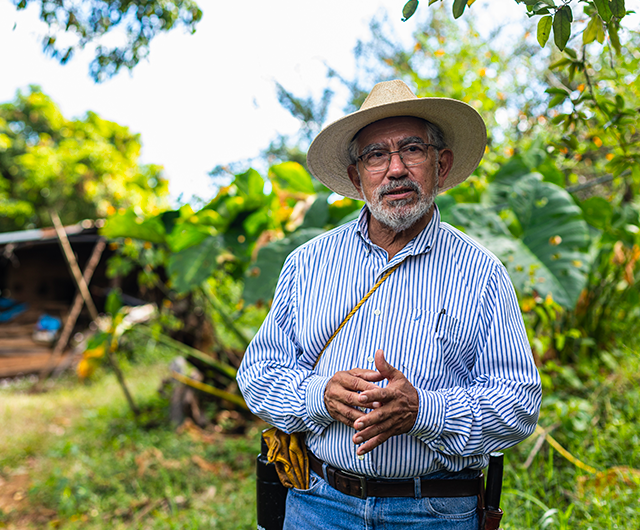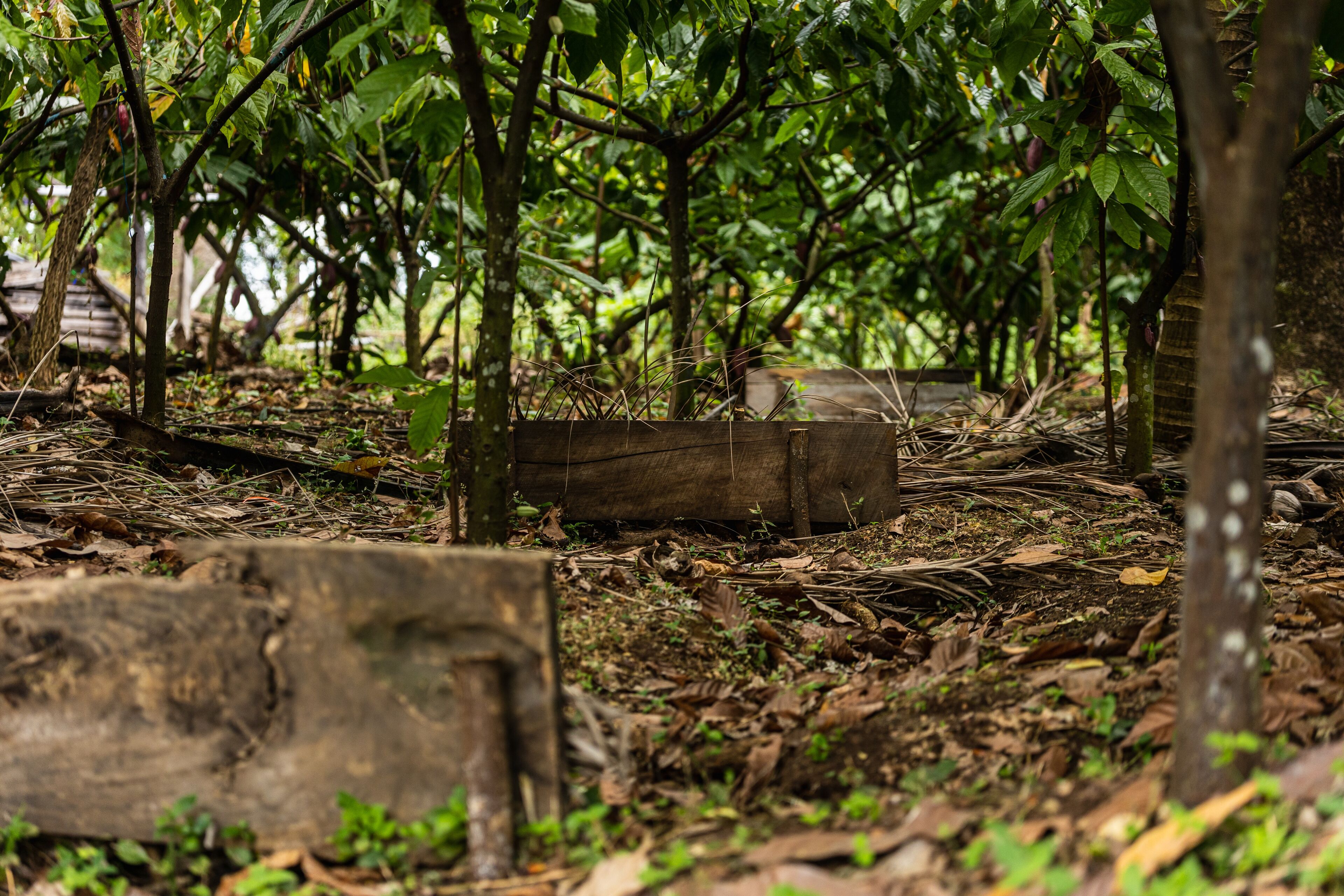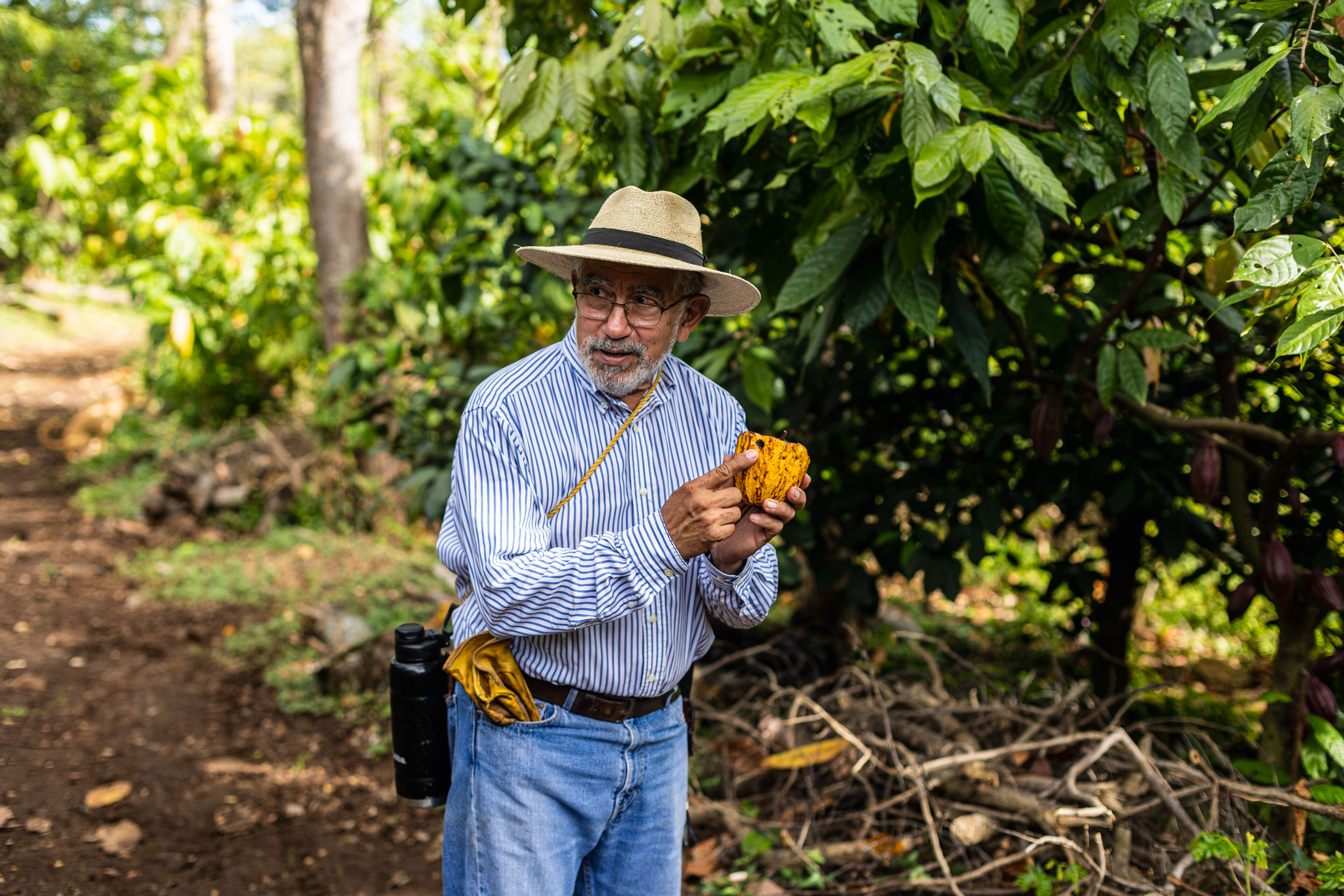
Meet el maestro Don Herbert Betancourt
In 2016, I heard from a friend that Don Herbert Betancourt was growing exotic varieties of cacao in Nahulingo, El Salvador. I contacted him to find out more about his cacao. That year, he told me that it wasn't the right time, that he wasn't ready yet. Dr Herbert Betancourt is a force to be reckoned with in El Salvador, both for his medical training and for his remarkable political career. Today, he is one of the producers we are most happy to visit. The cacao from the Chiquihuat farm is delicious and has many advantages. It can be used as ceremonial cacao and, of course, as the raw material for the world's finest chocolate bars.
Hello Don Herbert. What has changed since our first contact in 2016?
Thanks to my team and with the help of some magnificent technicians, we've gone from a utopia to a reality, albeit with room for improvement, but we're on the right track. We have had to overcome a number of challenges and correct the way we relate to our environment, because we have caused serious distortions that have penalised us in the past. We are pooling our knowledge, correcting our farming practices in the hope of counteracting the deterioration of the environment and having a better impact on our quality of life. My small farm, and those of my fellow cacao farmers, are already schools where we treat our land well so that it rewards us all.
Don Herbert, you are a doctor and a farmer. Can you tell us how this fusion of vocations manifests itself?
Ever since I was a child, I've been interested in studying the natural sciences. Visits to my grandmothers' farms and direct contact with nature made me very happy. But these trips also allowed me to discover the harsh reality of farming families. The vicious circle of subsistence farming coexisted with poverty, malnutrition, infectious diseases and insecurity. I studied medicine and public health, marked by the memories of those childhood years. My studies in public health opened up my vision and my field of work even further. Health is the product of many factors; medical care is important, but it is not enough. My list of priority factors for achieving a better quality of life and human development includes education, nutrition and the enjoyment of healthy conditions and environments. My contribution to this approach to development is to teach good farming practices. Growing cacao in agroforestry systems requires the use of precisely these good practices, particularly with regard to organic farming. But of course, things are not that simple.

Samples of theobroma bicolore and different types of cacao from Finca Chiquihuat.
How long have you been involved in cacao farming?
When I was 40 (Don Herbert is now in his sixties), I asked myself two questions: What have I been doing with my life all this time? And then of course the other, even more important question: Am I going to change anything from now on? The answer was not to change direction, but to add to my work in the field of health, the task that makes me happiest and brings me physical and mental health and collective projection: cultivating the earth. Putting a seed in the ground and seeing how this prodigious nature transforms it into food, medicine, shelter and peace is my achievement. I can't think of a better occupation. I wanted to create an integral farm applying the concepts of permaculture. I wanted a sustainable and diverse micro-environment. It was difficult, but I changed my approach because of all the information about the benefits of growing cacao. My father-in-law Pepe, who is always well-informed about everything, took the trouble to share some serious articles with me. He also told me about a Nicaraguan friend who, after an economic, social and environmental feasibility analysis, concluded that the best investment was to plant cacao.
The history of cacao in El Salvador is very interesting, we have a national heritage with a huge projection and visionary projects like those of the NGO Alianza Cacao that have accompanied us (from planting to marketing). To sum up, my adventure with cacao has lasted around 10 years. Since I started growing it, I've favoured the criollo varieties I found at CENTA (El Salvador's National Centre for Agricultural and Forestry Technology), or with friends like Jaime Arevalo. I have added to the clonal garden a few wild and unique varieties that I found by chance on the Ishuatan farm (a historic cacao-growing area 40 km from the Chiquihuat finca).
There has been a lot of talk about the problems with these varieties, which has caused their planting to fall behind that of the clones, which are recognised as being highly productive, fine, aromatic and resistant to pests. However, I have encouraged the planting of criollos on my farms. Colonial history records large-scale production with high profitability, but if I wanted to remain consistent with my idea of saving this rich heritage, I would have to plant OUR ANCESTRAL CACAO. I would also add as another historical fact that an important town like Sonsonate was founded for the cacao trade and that the port of Acajutla was built to export thousands of truckloads of Salvadoran cacao. I bet on the criollos, without underestimating the clones. What's interesting about this blend is that there has been a 'hybridisation' between the varieties and I'm happy with the results.
Could you tell us about the process of 'building' your farm?
As part of my initial integral farm project, I started by planting endangered native trees, both forest and fruit, with patches of pasture for goats and Pelibüey sheep (a breed of sheep bred in the Caribbean and South America for its meat). I quickly had to switch from an agroforestry system to an agroforestry system with cacao. The soil-transforming power of shrubby forages such as canavalia, cratilia, kudzu, mucuna and nitrogen-fixing trees has transformed Chiquihuat's soils in astonishing ways. Minimal tillage, the use of biostimulants, the work of mountain micro-organisms on fallen leaves, planting with water trays, run-off control, fire prevention and controlled pruning are the main tasks that have transformed a clay soil depleted by monocultures into a fertile and productive land. It's hard work for an empowered team who share the pride of building this island of green in the middle of an ocean of sugar cane fields. The team includes my friends, technicians from Alianza Cacao, CLUSA, Rikolto, IILA and others.
Letting nature do its work, breathing new life into this organism we call the soil, helping it a little with good practices based on knowledge of plant nutrition is an urgent and fundamental task.

I have a long list of trees planted by you and your team. When did you start reforesting?
In order to save our forest heritage, I planted 40 varieties of endemic trees, many of which are in danger of extinction. These native trees were felled in the past for their precious wood. In a few decades' time, this wood will contribute to the plantation's cash flow. I have also planted 30 varieties of fruit trees, all of which are currently productive. These timber trees and fruit trees have transformed this small forest into an oasis of protection and sustenance for the wildlife, which has increased significantly. Among the animals, there are some that we cacao farmers don't take too kindly to, notably squirrels and woodpeckers. We inevitably have to accept them because they are part of the cacao crop.

Can you tell me how you chose these types of tree?
To establish this small forest, I was guided by the characteristics and advantages of each species: size, form of shade, wind resistance, growth rate, type and use of fruit, ability to fix nitrogen, adaptation to altitude, resistance to seasonal changes, use and value of its wood... As living organisms interacting with one another, the individuals in the forest exchange vital elements that confer health and protection on the micro-environment in which they live. This exchange also affects us, human beings, when we walk under the canopy. If we pay attention, we will hear the symphony of the forest that will delight you and bring you health and inner peace. We have to pay attention.
What does cacao fermentation mean to you, and what do you think of unfermented cacao?
Experts in cacao growing and processing, as well as many chocolate makers, attach great importance to the biochemical transformation of cacao during fermentation. They claim that it is during fermentation that the best aromas develop. But this biochemical transformation means that we lose many of the chemical components in the cacao bean that have beneficial effects on health. Obviously, depending on how the beans are used, the process will also be different. In my case, I'm looking for a cacao (variety and process) that retains as many of its health benefits as possible, while still being appreciated by consumers. That's my mission.

During my last visits to your farm, I had the impression that you were prouder than ever of the taste of your cacao...is that true?
Yes, every day that I offer my cacao, I receive good comments on the organoleptic characteristics from professional and amateur tasters, especially those who sincerely tell you "I like it or I don't like it" or "it's special". But the ones who stimulate my ego the most are those who ask you to give them more chocolate. I insist that Chiquihuat cacao is a happy hybrid of criollos and trinitarios. Geneticists can correct me, but what we taste is special. If we go down this road, El Salvador will have a better chance of being considered as a new country of origin for cacao. For the time being, our relationship with BELCO opens the door to Europe and Asia, where our Salvadoran cacao is known and appreciated.
Did you like this article? Share it with your community:
